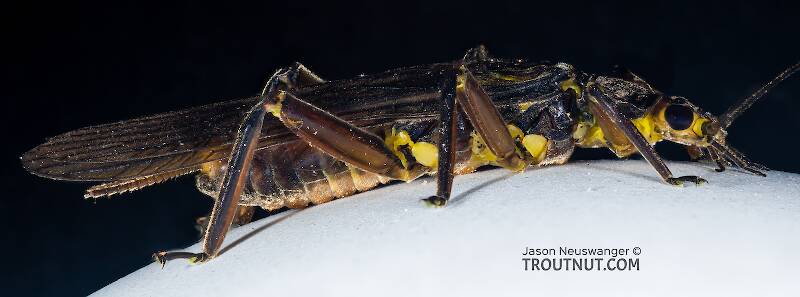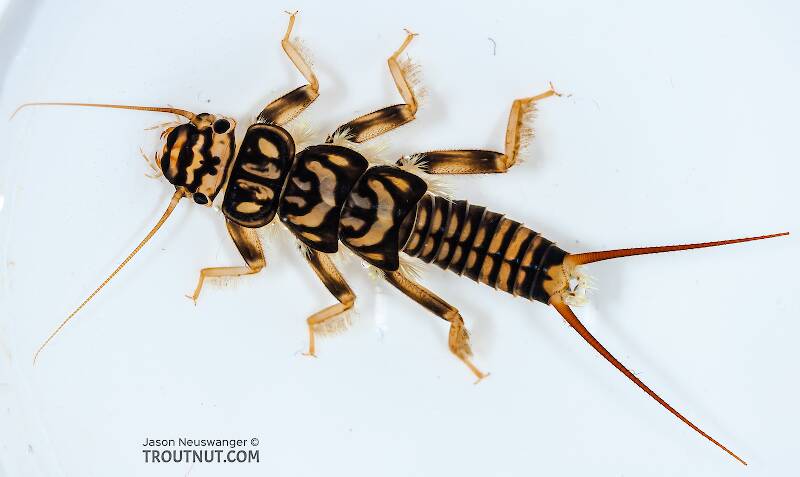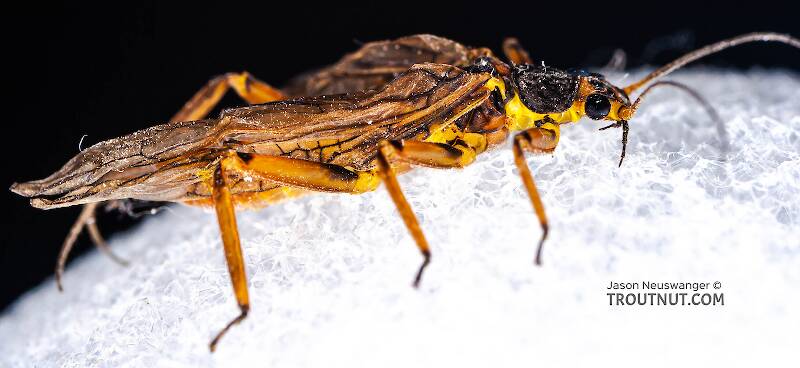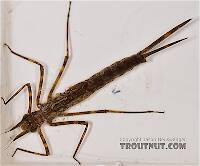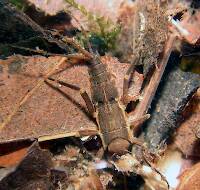
Hex Mayflies
Hexagenia limbata
The famous nocturnal Hex hatch of the Midwest (and a few other lucky locations) stirs to the surface mythically large brown trout that only touch streamers for the rest of the year.
Featured on the forum
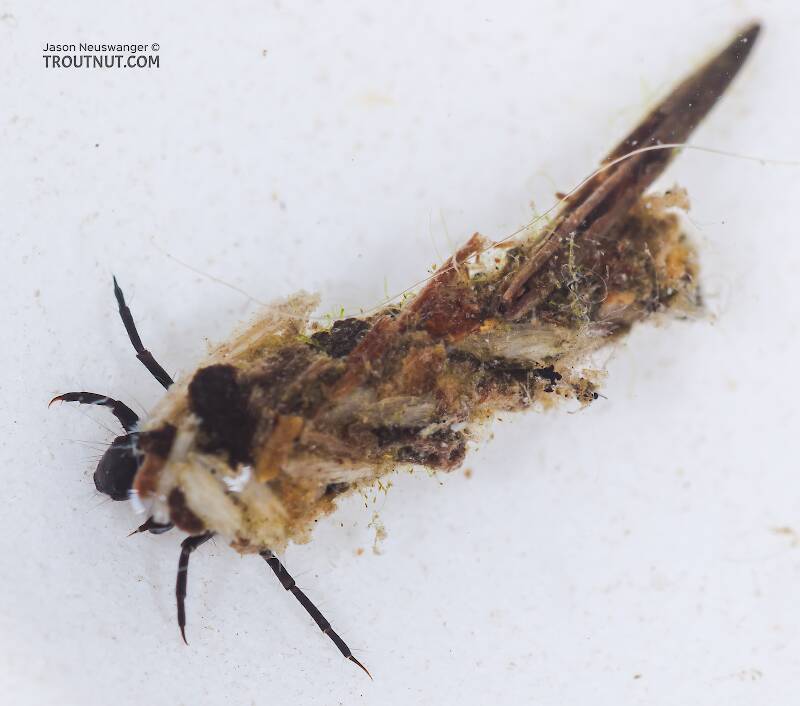
This seems to be a young larva of Limnephilus. Although not clear in the picture, several ventral abdominal segments have chloride epithelia.

Troutnut is a project started in 2003 by salmonid ecologist Jason "Troutnut" Neuswanger to help anglers and
fly tyers unabashedly embrace the entomological side of the sport. Learn more about Troutnut or
support the project for an enhanced experience here.
This topic is about the Stonefly Species Agnetina capitata
This is the most important Perlidae species in the East.Example specimens
DOS on Mar 31, 2009March 31st, 2009, 5:33 pm EDT
Hello gentlemen,
Again I come to you for guidance...
While monkeying around today in the aquarium, I flipped over a rock and this guy came scurrying out. I have recently been studying A. capitata and realized immediately that this might be a different species. Until now, I had thought that A. capitata was the only "golden stone" I had collected here in WNY to date, however I guess now I have one more under my belt! Is it weird that this excites me??
When I do my collecting on the stream and bring the insects home, I attempt to snap a pic of each before I place them in the aquarium, sort of a photographic inventory. This guy must have been hiding somewhere and was overlooked in that process.
So, anyone want to go out on a limb and confirm this as Cultus verticalis? Other than a measured length of 19mm, I can't really offer up any identifying features that aren't visible in the pictures. I don't have access to the M&C key. Anyone know if its posted online? I'll search my school library in a moment.
If it is C. verticalis, I've noticed that neither genus or species appear on the USGS Stoneflies of New York list. I see that Jason originally coded his specimen to the genus Arcynopteryx which contains three species. Again, none appear anywhere near WNY on the USGS list. Any other ideas of a possible alternative ID? http://www.npwrc.usgs.gov/resource/distr/insects/sfly/ny/toc.htm
If its not on the list, anyone know if and how I can submit my findings? Also, what is your experience with the USGS lists in regards to its accuracy and completeness? This and other instances have me thinking there are some holes in the data.
Unfortunately, this specimen perished as I was photographing it. I was hoping it would survive so that it might emerge and I could get snap photos as an adult. Tomorrow I'm heading to the location where I collected him to see if I can determine abundance in relation to A. capitata, as obviously the share the same lotic environment.
Thanks in advance!
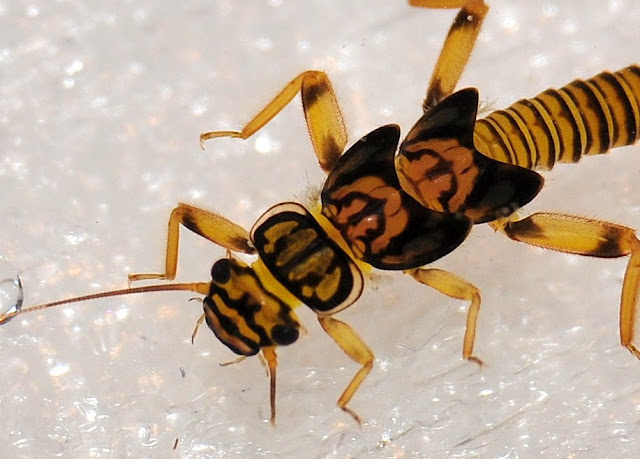
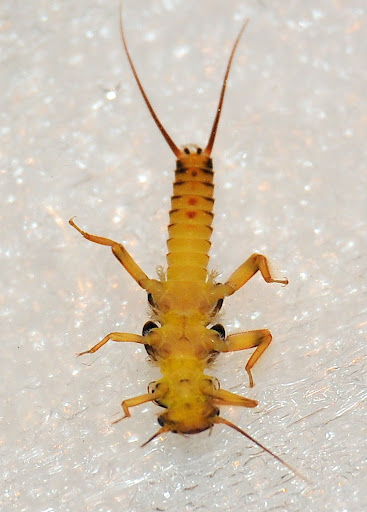
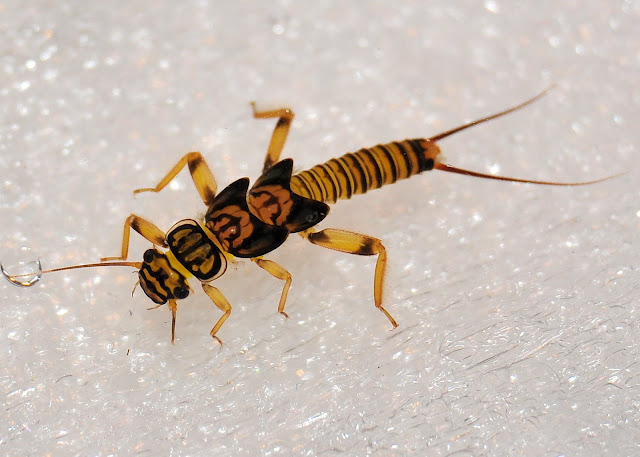
To enlarge the photos, you can right click ---> copy image location ---> then paste the URL in your browser
Again I come to you for guidance...
While monkeying around today in the aquarium, I flipped over a rock and this guy came scurrying out. I have recently been studying A. capitata and realized immediately that this might be a different species. Until now, I had thought that A. capitata was the only "golden stone" I had collected here in WNY to date, however I guess now I have one more under my belt! Is it weird that this excites me??
When I do my collecting on the stream and bring the insects home, I attempt to snap a pic of each before I place them in the aquarium, sort of a photographic inventory. This guy must have been hiding somewhere and was overlooked in that process.
So, anyone want to go out on a limb and confirm this as Cultus verticalis? Other than a measured length of 19mm, I can't really offer up any identifying features that aren't visible in the pictures. I don't have access to the M&C key. Anyone know if its posted online? I'll search my school library in a moment.
If it is C. verticalis, I've noticed that neither genus or species appear on the USGS Stoneflies of New York list. I see that Jason originally coded his specimen to the genus Arcynopteryx which contains three species. Again, none appear anywhere near WNY on the USGS list. Any other ideas of a possible alternative ID? http://www.npwrc.usgs.gov/resource/distr/insects/sfly/ny/toc.htm
If its not on the list, anyone know if and how I can submit my findings? Also, what is your experience with the USGS lists in regards to its accuracy and completeness? This and other instances have me thinking there are some holes in the data.
Unfortunately, this specimen perished as I was photographing it. I was hoping it would survive so that it might emerge and I could get snap photos as an adult. Tomorrow I'm heading to the location where I collected him to see if I can determine abundance in relation to A. capitata, as obviously the share the same lotic environment.
Thanks in advance!
To enlarge the photos, you can right click ---> copy image location ---> then paste the URL in your browser
Andrew Nisbet
GONZO on Mar 31, 2009March 31st, 2009, 5:43 pm EDT
Sorry, Drew, but it's another A. capitata. One interesting thing about this one is that it appears that the front and middle legs on the left side were regenerated at an earlier stage.
DOS on Mar 31, 2009March 31st, 2009, 6:05 pm EDT
Ahhh man! Thanks for the speedy reply Lloyd. I got all excited for nothing!! :)
Andrew Nisbet
DOS on Mar 31, 2009March 31st, 2009, 6:07 pm EDT
I guess the narrower, more elongated and banded abdomen threw me off. I need much more work in refining my identification eye.
But, as in previous misidentifications where you have helped me out I'm immediately seeing physical differences, I can run with that and do some more research to better hone my skills.
Lloyd, any opinions or experience on the completeness of the USGS data sets, Stones or Mayflies?
But, as in previous misidentifications where you have helped me out I'm immediately seeing physical differences, I can run with that and do some more research to better hone my skills.
Lloyd, any opinions or experience on the completeness of the USGS data sets, Stones or Mayflies?
Andrew Nisbet
GONZO on Mar 31, 2009March 31st, 2009, 6:18 pm EDT
Many distribution records tend to be somewhat incomplete or in need of updating on the USGS site. You should really take a look at the distribution records (and other great info) on Roger's website: http://www.flyfishingentomology.com
Troutnut on Apr 1, 2009April 1st, 2009, 9:51 am EDT
Neat critter, Andrew.
It is weird that this excites you, but you're in exactly the right place. We're all weird like that. Collecting a new bug, especially one that might be unusual, is always exciting.
Your nymph does look a lot like Cultus in the first picture, although the next two make it clear that it's not elongated enough. The most obvious physical difference to me, though, is that yours has gills in its armpits. (Ssshhh don't tell the entomologists I called them that.)
The Cultus nymph I found was the only one I ever saw, captured in a tributary of the Willowemoc.
The USGS distribution maps aren't often very good for judging the absence of something. They can tell you when something may be present, but plenty of things are overlooked. Nobody has done the rigorous sampling and identification it would take to make a really exhaustive catalog... what a project that would be!
It is weird that this excites you, but you're in exactly the right place. We're all weird like that. Collecting a new bug, especially one that might be unusual, is always exciting.
Your nymph does look a lot like Cultus in the first picture, although the next two make it clear that it's not elongated enough. The most obvious physical difference to me, though, is that yours has gills in its armpits. (Ssshhh don't tell the entomologists I called them that.)
The Cultus nymph I found was the only one I ever saw, captured in a tributary of the Willowemoc.
The USGS distribution maps aren't often very good for judging the absence of something. They can tell you when something may be present, but plenty of things are overlooked. Nobody has done the rigorous sampling and identification it would take to make a really exhaustive catalog... what a project that would be!
Jason Neuswanger, Ph.D.
Troutnut and salmonid ecologist
Troutnut and salmonid ecologist
DOS on Apr 1, 2009April 1st, 2009, 10:13 am EDT
Hey thanks for weighing in on this Jason!
When I first saw this nymph in my aquarium my heart started racing ah ha because right away I thought I recognized it from the homepage as Clutus and I knew it was a fairly rare find... especially here in NY. Buttt my hasty mis-identification just means I won't make the mistake next time and I have to keep flippin those rocks :)
Also, I have to thank you personally for providing such a intellectually stimulating, well rounded and above all well mannered forum that fosters this exact type of learning! I can't express how much fun I've had interacting with guys from this site and I can't fill my brain fast enough with the lessons and tidbits learned from all your combined knowledge. I've been really down on online fly fishing communities as of late because of the usual shenanigans so I'm quite grateful I've found a nice little home here!
When I first saw this nymph in my aquarium my heart started racing ah ha because right away I thought I recognized it from the homepage as Clutus and I knew it was a fairly rare find... especially here in NY. Buttt my hasty mis-identification just means I won't make the mistake next time and I have to keep flippin those rocks :)
Also, I have to thank you personally for providing such a intellectually stimulating, well rounded and above all well mannered forum that fosters this exact type of learning! I can't express how much fun I've had interacting with guys from this site and I can't fill my brain fast enough with the lessons and tidbits learned from all your combined knowledge. I've been really down on online fly fishing communities as of late because of the usual shenanigans so I'm quite grateful I've found a nice little home here!
Andrew Nisbet
Troutnut on Apr 1, 2009April 1st, 2009, 11:11 am EDT
Glad to have you! The thanks really goes to dozens of regular posters here who keep the conversation on an unusually high level for any website. I'm lucky you all showed up here. ;)
Jason Neuswanger, Ph.D.
Troutnut and salmonid ecologist
Troutnut and salmonid ecologist
Quick Reply
Related Discussions
Topic
Replies
Last Reply
8
Feb 12, 2009
by Troutnut
by Troutnut
2
Mar 21, 2007
by CalebBoyle
by CalebBoyle
Re: "The Frozen Chosen", or what I did yesterday instead of fly fishing

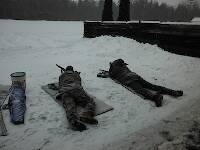
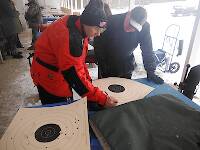


In the Photography Board by Jmd123





In the Photography Board by Jmd123
6
Feb 6, 2014
by Entoman
by Entoman


